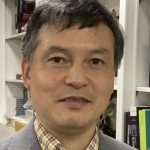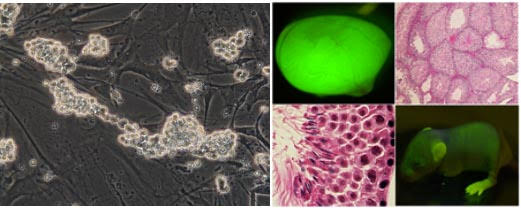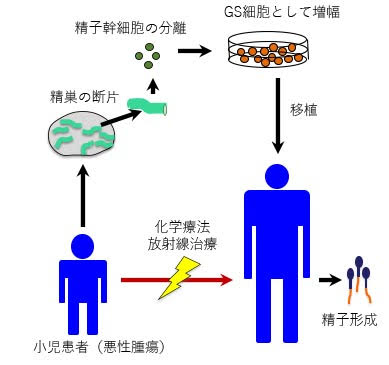
M. D., Ph. D. Professor Takashi Shinohara
Our long-term goal is to use spermatogonial stem cells (SSCs) for genetic modification. We have succeeded in long-term culture of mouse SSCs, which we designated germline stem (GS) cells. GS cells proliferate as spermatogonia in vitro but regenerate spermatogenesis upon introduction into seminiferous tubules. They maintain stable karyotype and fertility for more than 2 years, and can give rise to ES-like cells by dedifferentiation. Analysis of GS cells will increase our knowledge on the unique biology of the germline cells and contribute to the development of new transgenic technologies.
Research and Education
SSCs are the only stem cells in the body with germline potential. However, lack of culture methods has hampered their analysis. We have established GS cell cultures, and it has become possible to obtain a large number of SSCs for molecular and biochemical analyses. GS cells proliferate for more than 2 years without losing fertility, and we produced knockout mice by homologous recombination using GS cells. In the course of the gene targeting experiments, we also discovered that GS cells dedifferentiate into ES-like multipotent GS cells, which produce germline chimeras upon microinjection into blastocysts. Given that ES cells with germline potential have been derived only from mouse and rat, our GS cell technology be useful for understanding the biology of germ cells and may resolve current challenges with ES cells and contribute to the development of new transgenic technologies. We are trying 1) to understand the mechanism of SSC self-renewal and dedifferentiation, 2) to establish methods for in vitro spermatogenesis, and 3) to derive GS cells from other animal species.
 1) Growth of GS cells
1) Growth of GS cells
 2) Growth of mGS cells
2) Growth of mGS cells
Recent Publications
- Kanatsu-Shinohara, M., Naoki, H., and Shinohara, T. 2016. Nonrandom germline transmission of mouse spermatogonial stem cells. Dev. Cell 38, 248-261.
- Kanatsu-Shinohara, M., Tanaka, T., Ogonuki, N., Ogura, A., Morimoto, H., Cheng, P. F., Eisenman, R. N., Trumpp, A., and Shinohara, T. 2016. Myc/Mycn-mediated glycolysis enhances mouse spermatogonial stem cell self-renewal. Genes Dev. 30, 2637-2648.
- Kanatsu-Shinohara, M., Yamamoto, T., Toh, H., Kazuki, Y., Kazuki, K., Imoto, J., Ikeo, K., Oshima, M., Shirahige, K., Iwama, A., Nabeshima, Y., Sasaki, H. and Shinohara, T. 2019. Aging of spermatogonial stem cells by Jnk-mediated glycolysis activation. Proc. Natl. Acad. Sci. USA 116, 16404-16409.
- Kanatsu-Shinohara, M., Ogonuki, N., Matoba, S., Ogura, A. and Shinohara, T. 2020. Autologous transplantation of spermatogonial stem cells restores fertility in congenitally infertile mice. Proc. Natl. Acad. Sci. USA 117, 7837-7844.
- Morimoto, H., Yamamoto, T., Miyazaki, T., Ogonuki, N., Ogura, A., Tanaka, T., Kanatsu-Shinohara, M., Yabe-Nishimura, C., Zhang, H., Pommier, Y., Trumpp, A., and Shinohara, T. 2021. An interplay of NOX1-derived ROS and oxygen determines the spermatogonial stem cell self-renewal efficiency under hypoxia. Genes Dev. 35, 250-260.
Laboratory
Professor:Takashi Shinohara
Assistant professor:Mito Kanatsu-Shinohara,Satoshi Watanabe,Shiromoto Yusuke
TEL: +81-75-751-4160
FAX: +81-75-751-4169
e-mail:tshinoha@virus.kyoto-u.ac.jp
URL:https://www2.mfour.med.kyoto-u.ac.jp/molgen/index_e.html
